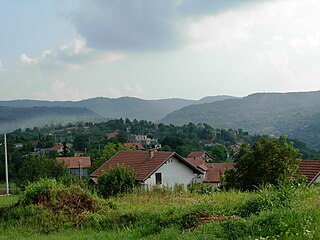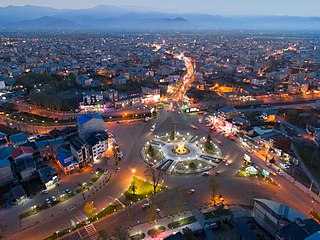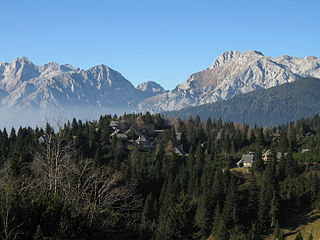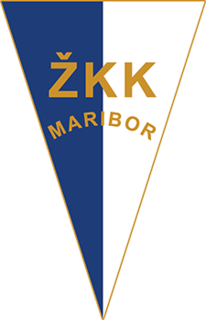
Astara is a city and capital of Astara County, Gilan Province, Iran. It lies on the border with Azerbaijan Republic and on the Caspian Sea. It is an important border trade center between Iran and the Caucasus.

The Coastal–Karst Statistical Region is a statistical region in southwest Slovenia. It covers the traditional and historical regions of Slovenian Istria and most of the Karst Plateau, which traditionally belonged to the County of Gorizia and Gradisca. The region has a sub-Mediterranean climate and is Slovenia's only statistical region bordering the sea. Its natural features enable the development of tourism, transport, and special agricultural crops. More than two-thirds of gross value added are generated by services ; most was generated by activities at the Port of Koper and through seaside and spa tourism. The region recorded almost a quarter of all tourist nights in the country in 2013; slightly less than half by domestic tourists. Among foreign tourists, Italians, Austrians, and Germans predominated. In 2012 the region was one of four regions with a positive annual population growth rate (8.1‰). However, the age structure of the population was less favourable: in mid-2013 the ageing index was 133.3, which means that for every 100 inhabitants under 15 there were 133 inhabitants 65 or older. The farms in this region are among the smallest in Slovenia in terms of average utilised agricultural area per farm and in terms of the number of livestock on farms.

Glavica is one of the neighborhoods of Sremska Kamenica, in Serbia. A southern part of Sremska Kamenica, it is about 4 kilometers from the Danube.

The Souvan House or the Hohn House is the highest building at Town Square in Ljubljana, the capital of Slovenia. It stands near Ljubljana Town Hall on the opposite (western) side of the square and has the address 24 Town Square. The building was originally erected in the late 17th century and renovated upon the plans by Francesco Coconi in 1827, who raised it and added a shallow avant-corps. Its façade from the early 19th-century is one of the highest-quality examples of Biedermeier architecture in the city. It is decorated with reliefs representing trade, art and agriculture, work by the travelling sculptor Martin Kirschner.

The Iška is a river of central Slovenia. Part of the river valley—the Iška Gorge or Iška Canyon —separates Lower Carniola from Inner Carniola. The river is 31 km (19 mi) long. After flowing past Strahomer, the river follows an almost straight line and joins the Ljubljanica River, and therefore belongs to the Sava and Black Sea basins.

Sowme'eh Sara is a city and capital of Sowme'eh Sara County, Gilan Province, Iran. At the 2006 census, its population was 36,522, in 10,070 families.

Poljane nad Škofjo Loko is a settlement in the Poljane Sora Valley in the Municipality of Gorenja Vas–Poljane in the Upper Carniola region of Slovenia.

Labinje is a village northeast of Cerkno in the traditional Littoral region of Slovenia.
Acta Chimica Slovenica is a quarterly scientific journal of chemistry. It comprises two parts: The first part contains peer-reviewed scientific and expert articles from the various fields of chemistry, written in English and accompanied by abstracts in Slovene. The second part, written in Slovene, contains societal news: lists of newly conferred academic degrees, reports on the work of the sections of the Slovenian Chemical Society, expert articles and book reviews, and news on conferences and other meetings.

The Upper Carniola Statistical Region is a statistical region in northwest Slovenia. It is a region with high mountains, including Mount Triglav, and is almost entirely Alpine. A large part of this statistical region is protected as a national park. The relief and climate are good bases for tourism. In 2013, the region recorded almost 19% of tourist nights in Slovenia, of which 78% were by foreign tourists. The region ranked second in Slovenia in number of tourist beds per 1,000 population, even though it had just over half as many beds as the Coastal–Karst Statistical Region. In 2013, the registered unemployment rate here was the lowest in Slovenia, 3 percentage points lower than the national average and more than 8 percentage points lower than in the Mura Statistical Region, where the registered unemployment rate was the highest. Although agriculture in this region is not among the most important activities, the farms are among the largest in the country both in terms of average utilised agricultural area per farm and in terms of the number of livestock per farm.

The Mura Statistical Region is a statistical region in northeast Slovenia. It is predominantly agricultural with field crops representing over three-quarters of the total agricultural area. Climate and soil combined have made it the region with the highest crop production, but its geographical position and inferior infrastructure put it at a disadvantage and it is the region of Slovenia with the lowest GDP per capita and the highest rate of registered unemployment.

The Carinthia Statistical Region is a statistical region in northern Slovenia along the border with Austria.

The Central Sava Statistical Region is a statistical region in Slovenia. This statistical region in the Sava Hills is the smallest region in the country in terms of both area and population. In early-2010 almost 41,700 people lived on 264 km², meaning that together with the Central Slovenia Statistical Region it is the most densely populated statistical region. The natural and geographic features of this region create conditions for industrial activities and more than a third of gross value added is still generated by manufacturing, mining, and other industry. In 2013, the region once again recorded the highest negative annual population growth rate (−11.9‰), which was mainly a result of migration to other statistical regions. Among all statistical regions in 2013, this region had the highest negative net migration between regions; namely, −9.5. This region also stands out by age of mothers at childbirth. In 2013 first-time mothers in the region were on average 28.5 years old, whereas first-time mothers in the Central Slovenia Statistical Region were on average 1 year older. In the same year, the number of unemployed persons increased further. The registered unemployment rate was among the highest in the country (16.6%). In comparison with other regions, this is 7 percentage points more than in the region with the lowest registered unemployment rate, Upper Carniola, and almost 1 percentage point less than in the region with the highest unemployment rate, the Mura Statistical Region. According to the labour migration index, this is the most residential statistical region. In 2013, 60% of people in the region worked in their region of residence, and 40% worked in another region.

The Lower Sava Statistical Region is a statistical region in Slovenia. It has good traffic accessibility and is located in the Sava and Krka Valleys, with hilly areas with vineyards and an abundance of water. It is the second-smallest statistical region in Slovenia. The only nuclear power plant in the country and Čatež spa are located in the region. The region annually spends EUR 22 million on environmental protection. In 2013, the employment rate in the region was 57.5%. The region was characterized by the largest difference between the employment rate for men and for women. In 2013 this region also stood out in number of convicted persons per 1,000 population (8.3).

The Big Pasture Plateau is a karstified mountain plateau in the Kamnik–Savinja Alps northeast of Kamnik, Slovenia. It measures 5.8 square kilometres and has an average elevation of 1,500 metres above sea level. Its highest point is Mount Gradišče, at 1,666 m (5,466 ft). There are numerous herders' dwellings that comprise several settlement areas: Velika Planina 'Big Pasture', Mala Planina 'Little Pasture', Gojška Planina 'Gozd Pasture', Tiha Dolina 'Quiet Valley', and others. The Big Pasture Plateau is a tourist destination both in winter as a ski resort and in summer as a place for relaxation.
Acta Geotechnica Slovenica is a biannual peer-reviewed scientific journal published by the University of Maribor, Faculty of Civil Engineering. The editor-in-chief is Ludvik Trauner. The journal covers fundamental and applied research in the areas of geomechanics and geotechnical engineering. Topics covered include soil and rock mechanics, engineering geology, environmental geotechnics, geosynthetics, numerical and analytical methods, computer modelling, field and laboratory testing.
Acta Geographica Slovenica is a peer-reviewed scientific journal of geography published by the Anton Melik Geographical Institute covering human geography, physical geography, and regional geography. The editor-in-chief is Blaž Komac. It was established in 1952 as Acta Geographica/Geografski Zbornik. In 2002 it merged with Geographica Slovenica, obtaining its current title reflecting this merger in 2003.

Železničarski košarkarski klub Maribor, commonly referred to as ŽKK Maribor or simply ŽKK, was a basketball team based in Maribor, Slovenia. The club was founded in 1946 and was dissolved after the 2005–06 season due to financial difficulties.

Thienorphine is a very potent, extremely long-acting, orally-active opioid analgesic with mixed agonist–antagonist properties which was developed by the Beijing Institute of Pharmacology and Toxicology as a potential treatment for opioid dependence. It is a high-affinity, balanced ligand of the μ-, δ-, and κ-opioid receptors, behaving as a partial agonist of the μ- and κ-opioid receptors and as an antagonist of the δ-opioid receptor. It also possesses relatively low affinity for the nociceptin receptor, where it acts as an antagonist.
Studia Historica Slovenica is a peer-reviewed academic journal covering the contemporary history. It is published by the Zgodovinsko društvo dr. Franca Kovačiča v Mariboru, based in Maribor and the editor-in-chief is Darko Friš. The journal was established in 2001.